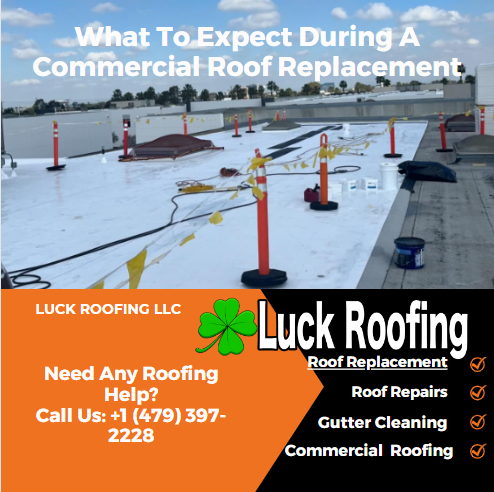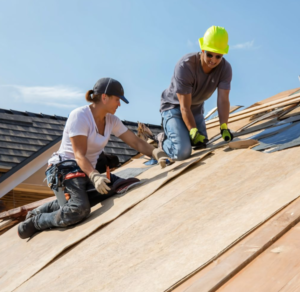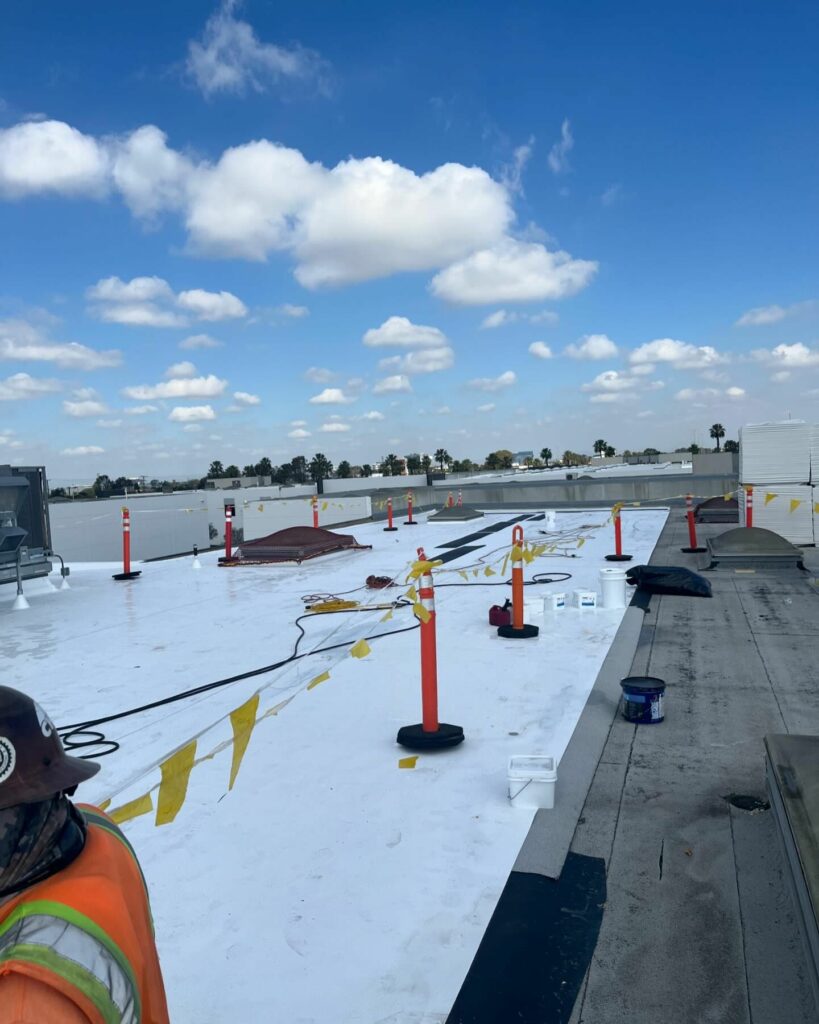 What To Expect During A Commercial Roof Replacement
What To Expect During A Commercial Roof Replacement
During a commercial roof replacement, businesses are poised to undergo a meticulous process overseen by certified specialists, ensuring a thorough evaluation and the development of a comprehensive action plan. As the project unfolds, a series of crucial steps are taken to guarantee the successful execution of the new roof, from initial inspection checklist to post-installation follow-up. But what about the unexpected challenges that might arise during this critical phase of property maintenance? Let’s explore the intricacies and considerations that go into a commercial roof replacement, shedding light on what lies ahead for property owners and managers.
Key Points From This Article
- Thorough assessment and planning ensure accurate diagnosis and repair recommendations.
- Safety measures and skilled crew guarantee a secure work environment and quality workmanship.
- Methodical material removal and surface preparation create a solid foundation for new roof installation.
- Final inspection, clean-up, and post-installation care enhance durability and customer satisfaction.
We all know the cost of commercial roof replacement is a high ticket job so finding the best roofing contractors in Arkansas is essential . That’s why Luck Roofing is your go to team , call us today for a free quote and full inspection.
Initial Roof Inspection
 During the initial roof inspection, roofing contractors typically check for blisters, cracks, uplifted seams, pools of water, and holes on the commercial property’s roof. This comprehensive inspection is crucial in identifying any existing issues that need to be addressed before proceeding with the roof replacement project. The inspection report generated from this assessment includes detailed information on areas of leaks and provides recommendations for necessary repairs.
During the initial roof inspection, roofing contractors typically check for blisters, cracks, uplifted seams, pools of water, and holes on the commercial property’s roof. This comprehensive inspection is crucial in identifying any existing issues that need to be addressed before proceeding with the roof replacement project. The inspection report generated from this assessment includes detailed information on areas of leaks and provides recommendations for necessary repairs.
Contractors may also conduct sampling during the inspection process to analyze the layers, materials, moisture content, and age of the roof, checking the different commercial roof types to locate the best option for your situation. This thorough evaluation ensures that all aspects of the commercial roof are taken into consideration before moving forward with the replacement. The inspection duration can vary depending on the size of the roof, with larger roofs potentially requiring up to an hour for a 20,000 square foot area.
After the initial roof inspection is completed, the comprehensive inspection report is usually finalized within 3 to 5 days. This report serves as a roadmap for the upcoming project, outlining the specific areas that require attention and the recommended course of action. By conducting a detailed and meticulous roof inspection, roofing contractors can ensure that the commercial property receives a durable and reliable new roof that meets all necessary standards.
Project Planning And Timeline
 Efficient project planning for a commercial roof replacement involves evaluating the surface area, complexities, and existing roof issues to ensure a streamlined process. To effectively manage the project and adhere to a timeline, the following key considerations are essential:
Efficient project planning for a commercial roof replacement involves evaluating the surface area, complexities, and existing roof issues to ensure a streamlined process. To effectively manage the project and adhere to a timeline, the following key considerations are essential:
- Assessment of Surface Area: Understanding the total area that needs replacement is crucial for proper resource allocation and scheduling.
- Evaluation of Complexities: Identifying any intricate features or design elements of the existing roof that may impact the replacement process is vital for planning.
- Addressing Existing Roof Issues: Prioritizing and resolving any pre-existing problems with the current roof before commencing the replacement helps prevent complications during the project.
- Establishing a Realistic Timeline: Creating a detailed timeline that considers the size of the roof, potential challenges, and weather conditions is necessary for efficient project management.
Work Crew Preparation
 Assembling a team of skilled and experienced roofers is the initial step in work crew preparation for a roof replacement project. Commercial roofing contractors carefully select their roofers based on their expertise and experience to ensure a smooth and efficient replacement process. These roofers are equipped with the necessary safety gear, including harnesses, hard hats, and non-slip footwear, to guarantee their well-being while working at heights. Additionally, they are provided with the tools required for the replacement project, such as nail guns, hammers, and shovels.
Assembling a team of skilled and experienced roofers is the initial step in work crew preparation for a roof replacement project. Commercial roofing contractors carefully select their roofers based on their expertise and experience to ensure a smooth and efficient replacement process. These roofers are equipped with the necessary safety gear, including harnesses, hard hats, and non-slip footwear, to guarantee their well-being while working at heights. Additionally, they are provided with the tools required for the replacement project, such as nail guns, hammers, and shovels.
To enhance the team’s capabilities, training sessions may be conducted to ensure that the roofers are well-versed in handling materials and equipment safely and effectively. Coordination meetings are also held to discuss each member’s roles, responsibilities, and the safety protocols that need to be followed throughout the project. Moreover, emergency response plans are put in place to address any unforeseen incidents promptly and efficiently, prioritizing the safety of the crew members and minimizing any potential risks during the replacement. This thorough work crew preparation sets the foundation for a successful and secure roof replacement project.
Roof Material Removal

Carefully removing old roofing materials is a critical step in preparing the roof deck for the installation of new roofing materials during a replacement. The process of roof material removal involves systematically stripping away layers of old roofing materials to expose the roof deck underneath. Here are some key points to consider during the roof material removal phase:
- Thorough Inspection: Contractors inspect the roof deck for any damage or issues as they remove the old roofing materials. This inspection helps identify any underlying problems that need to be addressed before installing the new roof.
- Methodical Stripping: Old roofing materials are methodically stripped away to ensure that the roof deck is properly exposed and prepared for the new roofing materials. This step is crucial in creating a clean and stable surface for the upcoming installation.
- Surface Preparation: Proper removal of old materials is essential for preparing the roof deck to receive the new roofing materials. Any debris or damaged areas must be addressed to guarantee a smooth and effective replacement process.
- Foundation for Success: The roof material removal sets the foundation for a successful project. By taking the time to remove the old materials carefully, contractors can ensure that the new roof will be installed on a solid and secure surface.
Surface Preparation
Properly preparing the surface by removing the old roofing material is essential before installing the new commercial roof system. This process involves a detailed inspection of the roof deck to assess any damage or deterioration that may have occurred over time. Identifying and addressing these issues during the surface preparation stage is crucial for ensuring the structural integrity of the new roof.
Once the old roofing material has been removed, the next step in surface preparation is to thoroughly clean and clear the roof deck. This step is important for promoting proper adhesion of the new roofing materials and preventing any potential issues that could arise from debris or contaminants on the surface.
In addition to cleaning the roof deck, it is common practice to apply necessary sealants, adhesives, and primers during the surface preparation phase. These products help create a suitable foundation for the new roof system, ensuring that it adheres securely and performs effectively over time.
Ultimately, proper surface preparation is a critical component of the replacement process. By investing time and effort into preparing the surface correctly, property owners can help extend the longevity and effectiveness of their new roof system.
Installation Process
 Contractors typically start by moving necessary materials onto the roof surface when initiating the installation process for a replacement. The process involves several key steps:
Contractors typically start by moving necessary materials onto the roof surface when initiating the installation process for a replacement. The process involves several key steps:
- Installing New Insulation: Contractors begin by installing a new layer of insulation on top of the existing decking. This step helps improve energy efficiency and provides better temperature regulation within the building.
- Applying Waterproof Membrane: A waterproof membrane is then applied on top of the insulation to create a watertight seal. This membrane serves as a protective barrier against water infiltration, helping to prevent leaks and water damage.
- Sealing Vents and Features: Features like vents or chimneys are sealed to prevent leaks and maintain the roof’s integrity. Proper sealing ensures that there are no weak points where water could seep through.
- Installing Roofing Material: Finally, the chosen roofing material, such as shingles, tiles, metal features, or a roof coating, is installed with precision. This step is crucial in ensuring the longevity and durability of the new roof, as it provides the outermost layer of protection against the elements.
Noise And Disruption Management
Efforts are made to minimize noise levels during commercial roof replacements to ensure minimal disruptions for building occupants. Throughout the project, measures are implemented to keep noise levels as low as possible. One key strategy is confining the majority of noise to the rooftop area, which helps reduce disturbances within the building. Additionally, the impact of insulation on noise levels is taken into consideration, and specific techniques are employed to minimize noise generated during material removal.
Moreover, after the installation is complete, thorough site cleaning is conducted to further mitigate any noise that may affect building occupants. This attention to noise control measures demonstrates a commitment to minimizing disruptions and creating a more comfortable environment. By focusing on noise management, the goal is to carry out the project efficiently while ensuring that the daily operations of the building occupants are impacted as little as possible. This careful approach to noise and disruption management is an essential part of delivering a successful and considerate experience.
Clean-Up And Final Inspection
After completing a commercial roof replacement, the final phase involves thorough clean-up and inspection to ensure quality and safety standards are met.
- Removal of Old Materials: Clean-up afterwards typically involves removing old materials from the site.
- Final Inspection: Final inspection ensures that the new roof meets quality standards and specifications.
- Daily Clean-Up: Daily clean-up efforts help contain mess to the rooftop area during the replacement process.
- Thorough Site Cleaning: Thorough site cleaning post-installation ensures a tidy and safe work environment.
During the clean-up process, it is essential to remove any debris, nails, or equipment left behind to prevent safety hazards and maintain the property’s aesthetics. The final inspection is crucial to verifying that the new roof has been correctly installed, sealed, and meets all necessary quality standards. This inspection ensures that the commercial property is left with a durable and reliable roof that will provide long-lasting protection. By adhering to these clean-up and inspection procedures, both the contractors and the property owner can be confident in the quality and safety of the newly replaced commercial roof.
Post-Installation Follow-Up
Following the completion of the roof replacement project, attention shifts to the post-installation follow-up, which typically includes a final inspection to ensure the new roof meets expectations. This phase is crucial for addressing any outstanding issues, providing maintenance tips, discussing warranties, and ultimately ensuring customer satisfaction. During the post-installation follow-up, contractors may offer guidance on how to maintain the new roof properly to maximize its lifespan.
To emphasize the importance of the post-installation follow-up, a table highlighting key aspects can be beneficial:
| Post-Installation Follow-Up |
|---|
| Final Inspection |
| Maintenance Tips |
| Warranties |
The final inspection conducted during the follow-up process serves as a quality check to guarantee that the new roof has been installed correctly and meets the required standards. Additionally, contractors may share maintenance tips to help the property owner care for the roof effectively, prolonging its durability. Discussions about warranties and guarantees are also common during this phase to provide the client with peace of mind regarding the investment made in the new roof replacement. Ultimately, the post-installation follow-up plays a significant role in ensuring customer satisfaction and addressing any concerns promptly.
And Finally
To summarize, undergoing a commercial roof replacement involves a detailed evaluation, meticulous planning, skilled workmanship, and thorough clean-up. Business owners and property managers can expect a professional and efficient process, resulting in a durable and dependable new roof for their commercial property. By partnering with experienced specialists and following a comprehensive action plan, clients can navigate through this significant renovation with confidence and peace of mind.
Michael Overzat
Michael Overzat resides in Fort Smith, Arkansas with his wife and three kids. He enjoys to hike, skateboard, write, and get involved in charity organizations. He was originally born in Maryland. He has worked within the roofing industry for 5 years and is very active within the industry by attending conferences, masterminds, etc. His vision is to create a multi-state organization that has a customer centric model. He's worked for some of the biggest names in the industry and hopes to create a more people focused model for the roof replacement process.
